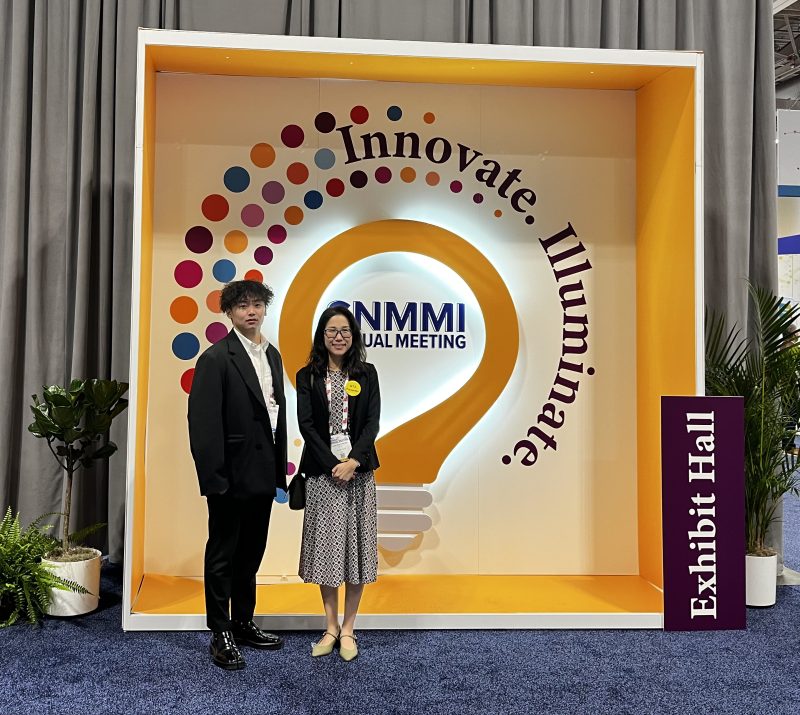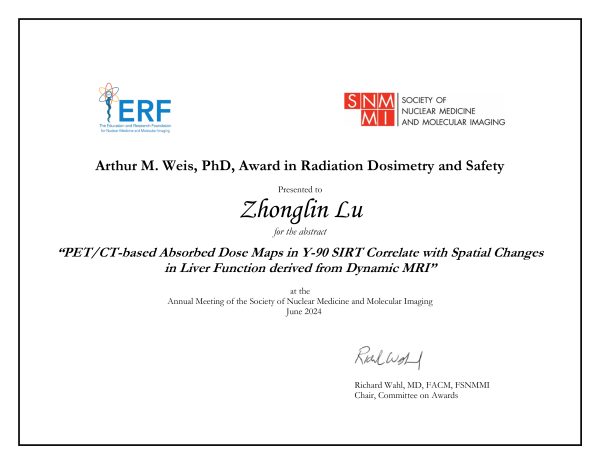UM team receives awards at annual meeting of Society of Nuclear Medicine and Molecular Imaging
澳大研究團隊獲北美核醫學與分子影像年會獎項


澳大研究團隊參加2024年北美核醫學與分子影像年會, 王炳杰(左)與莫昇萍教授
The UM’s research team at the 2024 Society of Nuclear Medicine and Molecular Imaging Annual Meeting, Bingjie Wang(left) and Prof. Seng Peng Mok, Greta
 |
 |
|
博士畢業生盧忠琳榮獲Arthur M. Weis獎 |
博士生王炳杰獲得國際最佳摘要獎 |
The Biomedical Imaging Laboratory (BIG) from Faculty of Science and Technology (FST) recently participated in the 2024 Society of Nuclear Medicine and Molecular Imaging (SNMMI) Annual Meeting held in Toronto, Canada. The team had 10 abstracts accepted for the meeting, including 2 oral and 8 posters presentations. Among them, 4 works were selected as meeting highlights. Additionally, a recent BIG’s PhD graduate, Zhonglin Lu, received the Arthur M. Weis Award in Radiation Dosimetry and Safety, which recognizes outstanding original work in radiation safety and dosimetry, for her work entitled “PET/CT-based Absorbed Dose Maps in Y-90 SIRT Correlate with Spatial Changes in Liver Function derived from Dynamic MRI”. This work has also been accepted for publication by Journal of Nuclear Medicine, a top journal in radiology and medical imaging. Another PhD student of BIG, Bingjie Wang received the International Best Abstract Award for his work, “Prediction of Coronary Artery Stenosis Using Myocardial Perfusion Stress/Rest SPECT: a Radiomics Study”. The UM research team once again shined on the world stage, showcasing latest research achievements in dosimetry and AI in nuclear medicine.
The two projects were led by Prof. Greta Mok from the FST. The first study revealed the correlation between absorbed dose maps based on PET/CT for Y-90 selective internal radiation therapy (SIRT), an effective treatment for primary and metastatic liver cancer, and spatial changes in liver function derived from dynamic MRI. This work is a joint effort between two UM, University of Macau and University of Michigan, where Lu spent her final year of PhD study as a visiting student. This is the first study ever to use MRI to assess liver toxicity of SIRT, and results shed new lights on SIRT patient management. The second study utilized radiomics to predict coronary artery stenosis using myocardial perfusion stress/rest SPECT, demonstrating state-of-the-art predictive performance. The two works are supported by FDCT grants (0099/2021/A) and (0016/2023/RIB1) respectively.
Held in North America, the SNMMI is the most influential international conference in nuclear medicine and molecular imaging. It attracts >8000 leading molecular imaging and nuclear medicine professionals to participate worldwide this year.
澳門大學科技學院電機及電腦工程系生物醫學影像實驗室(BIG)近期參加了加拿大多倫多舉行的2024年北美核醫學與分子成像學會(SNMMI)年會。團隊有10篇摘要獲會議錄取,包括2篇口頭報告和8篇海報展示,當中4項研究被選為會議亮點。此外,博士畢業生盧忠琳憑藉題為“動態MRI展示的肝功能空間變化與Y-90 SIRT的PET/CT吸收劑量圖的相關性”的研究,榮獲會議中表揚優秀放射劑量學與安全原創工作的Arthur M. Weis獎,該研究更獲醫學影像領域頂尖期刊《核醫學雜誌》發表。另一位博士生王炳杰憑藉其題為“使用心肌灌注負荷/靜息SPECT放射組學預測冠狀動脈狹窄”的研究,獲得國際最佳摘要獎。UM-BIG研究團隊再次在國際舞台上大放異彩,展示了在劑量學和人工智能在核醫學領域的最新研究成果。
該兩項研究項目均由科技學院電機及電腦工程系的莫昇萍教授帶領。第一項研究針對一種有效治療原發和轉移性肝癌的方法—釔-90選擇性內部放射治療(SIRT),揭示了基於PET/CT的Y-90 SIRT的吸收劑量圖與動態MRI得出的肝功能空間變化之間的相關性。該研究是澳門大學和美國密歇根大學的聯合工作,盧博士在她在澳大攻讀博士學位的最後一年遠赴密歇根大學訪學並完成了該研究。是全球首次使用MRI評估SIRT的肝毒性,結果為SIRT患者的管理提供了新的見解。第二項研究利用放射組學在心肌灌注負荷/靜息SPECT上預測冠狀動脈狹窄,並展示了世界最前沿的預測性能。這兩項研究分別得到了澳門科技發展基金(FDCT)項目(0099/2021/A)和(0016/2023/RIB1)的資助。
SNMMI年會每年在北美舉行,是核醫學與分子影像領域最具影響力的國際會議。今年吸引了來自全球超過8000位核醫學專業人士參加。